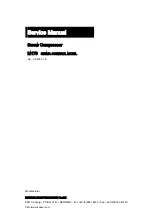
070.250-IOM (APR 11)
Page 6
408 MM ROTARY SCREW COMPRESSOR
INSTALLATION - OPERATION - MAINTENANCE
compressor Vi. Both are hydraulically controlled through
the solenoid valves located on the compressor cylinder
housing.
Proper operation of the 408 mm compressor slide valve and
slide stop require the use of a pump to boost oil pressure
above discharge pressure.
Oil from the pump is piped to the SC-13 port located on the
solenoid block which is mounted on the compressor cylinder
housing. The cylinder oil booster pump pressure shall be
regulated to maintain a minimum 40 PSID oil pressure boost
above discharge pressure.
Refer to CES 6606 for basic oil pump requirements and
basic piping diagrams. Actual system operating conditions
may necessitate the need for piping systems other than
those addressed by CES 6606. Contact Johnson Controls-
FRICk Service for assistance.
DEMAND OIL PUMP
A demand oil pump is required for low differential pressure
applications (CoolWare
™
will provide a warning when the oil
differential pressure is too low). Oil being supplied to the
compressor from the oil separator is at system discharge
pressure. Within the compressor, oil porting to all parts of
the compressor is vented back to a location in the
compressor’s body that is at a pressure lower than
compressor discharge pressure. All oil entering the
compressor is moved by the compressor rotors out the
compressor outlet and back to the system oil separator.
CONSTRUCTION DETAILS
HOUSING:
All 408 mm screw compressor castings are
ductile iron to ensure structural integrity and mechanical
and thermal stability under all operating conditions. Steel
housings are also available for special applications. Contact
Johnson Controls–Frick Sales for additional information.
ROTORS:
The rotors are machined from AISI-1141 steel to
the exacting tolerances of the latest Frick profile. The five-
lobed male rotor is directly connected to the driver. The
seven-lobed female rotor is driven by the male on a thin oil
film.
BEARINGS:
Antifriction bearings are used for reduced
frictional horsepower and superior rotor positioning,
resulting in reduced power consumption, particularly at
higher pressure ratios. Cylindrical roller bearings are
provided to handle the radial loads and the thrust loads are
absorbed by angular contact bearings. In addition, thrust
balance pistons are provided to reduce the thrust load and
improve bearing life.
SHAFT SEAL:
The compressor shaft seal is a single-face
type with a spring-loaded carbon stationary surface riding
against a stainless steel rotating seat. The seal is capable of
withstanding static pressure up to 600 psig. During
operation it is vented to low pressure to provide extended
life.
VOLUMIZER VARIABLE VOLUME RATIO CONTROL:
The
Frick compressor includes a method of varying the internal
volume ratio to match the system pressure ratio. Control of
the internal volume ratio eliminates the power penalty
associated with over- or under-compression. Volume ratio
control is achieved by the use of a slide stop which is a
movable portion of the rotor housing that moves axially with
the rotors to control discharge port location. The slide stop
is moved by hydraulic actuation of a control piston.
STEPLESS CAPACITY CONTROL:
Capacity control is
achieved by use of a movable slide valve. The slide valve
moves axially under the rotors to provide fully modulated
capacity control from 100% to minimum load capacity.
Minimum load capacity varies slightly with compressor
model, pressure ratio, discharge pressure level, and rotor
speed.
The slide valve is positioned by hydraulic movement of its







































